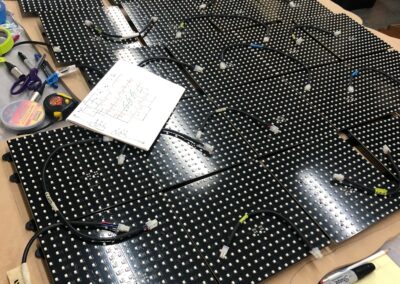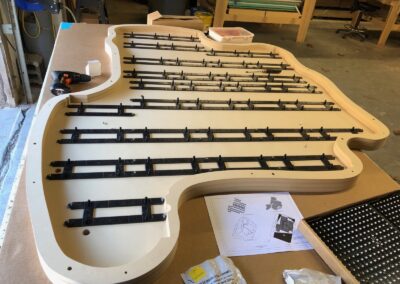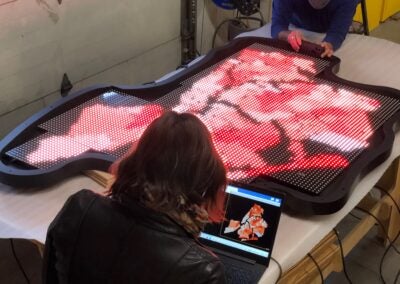ILLUMINATING COVID-19
by Mary-Elizabeth Lough
There are many ways of looking at the COVID-19 epidemic, but what Tulane alums Alexandra Payne (NC ’04) and Robyn Squires (A ’03) have done with their Illuminate: Covid-19 project is to give viewers an opportunity to really see the impact of the virus, layering dense information into a visual format that is as arresting as it is informative.
Illuminate Covid-19 uses a Video-LED lightbox to present viewers with the graphically familiar shape of New York’s five boroughs. Data representing four categories (illness, mortality, poverty and race) is then translated into mappings using light intensity and color saturation. As viewers take in the lightshow, the lights do what they do best — expose. In this case, the systemic inequities embedded and demonstrated in the impact of COVID-19 on New York City.
For Payne, the purpose is five-fold, “exposing the discrepancies we saw [in the impact of COVID-19], increasing awareness, fostering dialog, bridging a data access gap, and encouraging direct action to address the structures that contribute to them.”
Illuminate Covid-19 uses data drawn from NYC Department of Health and Mental Hygiene and the United States Census and American Communities Survey, translating the information into an immediately accessible visual display that interprets and exposes data patterns for the viewer. Squires regards the finished piece as a vessel for translation, noting “Art has the potential to evolve as the architecture of process, phasing an idea from the real to the abstract. Through this vessel we are able to communicate these layers of information in a didactic and meaningful way.”
![Illuminate_Light Data Map Test_IMG_6388[73]](https://stories.tulane.edu/wp-content/uploads/sites/2/2021/05/Illuminate_Light-Data-Map-Test_IMG_638873-scaled.jpeg)
There are many ways of looking at the COVID-19 epidemic, but what Tulane alums Alexandra Payne (NC ’04) and Robyn Squires (A ’03) have done with their Illuminate: Covid-19 project is to give viewers an opportunity to really see the impact of the virus, layering dense information into a visual format that is as arresting as it is informative.
Illuminate Covid-19 uses a Video-LED lightbox to present viewers with the graphically familiar shape of New York’s five boroughs. Data representing four categories (illness, mortality, poverty and race) is then translated into mappings using light intensity and color saturation. As viewers take in the lightshow, the lights do what they do best — expose. In this case, the systemic inequities embedded and demonstrated in the impact of COVID-19 on New York City.
For Payne, the purpose is five-fold, “exposing the discrepancies we saw [in the impact of COVID-19], increasing awareness, fostering dialog, bridging a data access gap, and encouraging direct action to address the structures that contribute to them.”
Illuminate Covid-19 uses data drawn from NYC Department of Health and Mental Hygiene and the United States Census and American Communities Survey, translating the information into an immediately accessible visual display that interprets and exposes data patterns for the viewer. Squires regards the finished piece as a vessel for translation, noting “Art has the potential to evolve as the architecture of process, phasing an idea from the real to the abstract. Through this vessel we are able to communicate these layers of information in a didactic and meaningful way.”
When COVID-19 hit the Lower East Side of Manhattan where Squires lives, she came face-to-face with hazmat-suited medical professionals who abruptly appeared in her building’s hallways. Against a pandemic that inherently and necessarily divided even close-knit communities, Squires, as a third-generation resident, wanted to give back to hers — and to shed a little light in the process.
Payne felt a similar impulse, germinating from a comment her boyfriend made — one which proved to be the impetus for developing the piece. A native of Italy, who did his studies in Milan, which was hard-hit just as New York was, he remarked that there should be a blackout to honor the many lost to COVID-19. Barring that feat, they decided to use light to explore the concept. Payne, who is an urban planner and policy consultant at Amplify Planning in New York City, says, “Unlike other global and national tragedies, pandemics are rarely memorialized. Individuals who personally experienced the virus – the sick and those devastated by deaths in their families and networks – deserve to have these experiences acknowledged and reified.”
“Individuals who personally experienced the virus – the sick and those devastated by deaths in their families and networks – deserve to have these experiences acknowledged and reified”
At Tulane, Payne began as a psychology major, then turned to sociology. But her path was always marked by, well, actual paths in the form of the streets and neighborhoods of New Orleans. As she traversed the city’s diverse neighborhoods to attend class at Tulane and tutor in various wards across the city, her interest in community structure and cohesion developed into a fascination. Ultimately, the path led her to pursue her Master of Science in urban planning from the London School of Economics.
The flexibility and willingness to grow that both women took from their Tulane careers into their postgraduate lives, is represented in Illuminate Covid-19 too. As coronavirus continues to reveal telling disparities within the culture, Illuminate Covid-19 itself continues to evolve and raise awareness. Looking ahead, they plan to build it out with additional data and images. The plan is for one addition that demonstrates the neighborhood percentages of vaccinated individuals, while a second addition would overlay health insurance rates in the same geographic area.
The simplicity of design afforded by the Video-LED lightbox offers another feature — the capacity to take often inaccessible and complex data and translate it into easily interpretable imagery. Ultimately, using art as a tool of communication. The group hopes to continue to develop projects for NYC and other cities, which would use an array of data and visual presentations to reveal complex cultural truths embedded within sometimes-overwhelming statistics. Perhaps a shade of Tulane there too. As graduates from a famously resilient school in a famously resilient city, they hope Illuminate Cities can play a part in imagining more resilient cities around the world.

Follow us on Social Media
Update Your Information
It only takes a moment to update your contact information and helps to ensure that you receive the latest news, exciting updates, invitations to events and more from Tulane University. Please update your most recent contact information by filling out the form below.



